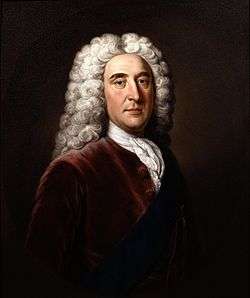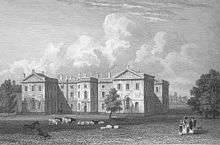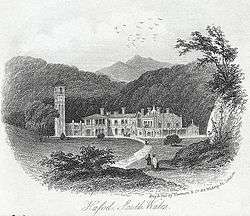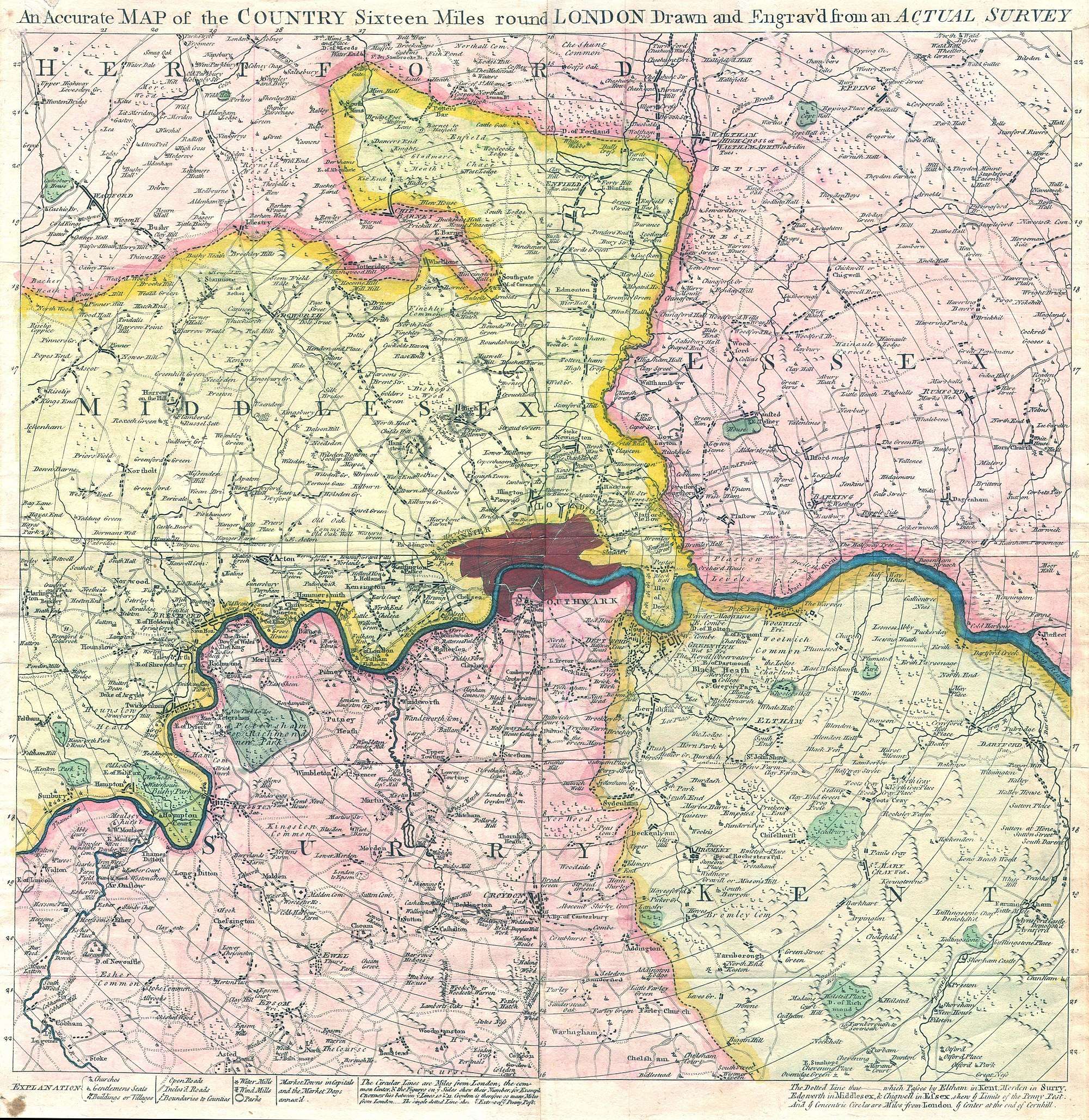Duke of Newcastle
Duke of Newcastle upon Tyne is a title that has been created three times. The related title Duke of Newcastle-under-Lyne [sic] has been created once to provide a slightly more remote special remainder. The title first was conferred in 1665 when William Cavendish was made Duke of Newcastle upon Tyne. He was a prominent Royalist commander in the Civil War. He had already been elevated as Viscount Mansfield in 1620, Baron Cavendish of Bolsover and Earl of Newcastle upon Tyne in 1621 and Marquess of the latter in 1643, and was created Earl of Ogle as main subsidiary title to the dukedom to be used as a courtesy style for his heir presumptive.
| Dukedom of Newcastle | |
|---|---|
| Creation date | 1665 (first creation) 1694 (second creation) 1715 and 1756 (third creation) |
| Monarch | Charles II (first creation) William III and Mary II (second creation) George I and George II (third creation) |
| Peerage | Peerage of England (first creation) Peerage of Great Britain (second and third creation) |
| First holder | William Cavendish, 1st Duke of Newcastle |
| Last holder | Edward Pelham-Clinton, 10th Duke of Newcastle |
| Remainder to | the 1st Duke's heirs male of the body lawfully begotten Special remainder for the third creation |
| Subsidiary titles | Marquess of Clare Earl of Ogle Viscount Mansfield Baron Cavendish of Bolsover |
| Extinction date | 1691 (first creation) 1711 (second creation) 1988 (third creation) |
| Seat(s) | Clumber Park |
The titles became extinct in 1988, a year that saw the deaths of the distantly related ninth and tenth Dukes of Newcastle-under-Lyne.
Despite the name of the town being "Newcastle-under-Lyme" with an "m", the dukedom was created with "Lyne" with an "n". There is no known satisfactory explanation for the discrepancy, which may have been an error. However, if it was an error, that error has perpetuated itself in numerous sources, including peerage catalogues.
Details of each creation
- Family background
Cavendish was the son of Sir Charles Cavendish, third son of Sir William Cavendish and his wife Bess of Hardwick. William Cavendish, 1st Earl of Devonshire, was his uncle (see the Duke of Devonshire for further history of this branch of the family). Sir Charles Cavendish married as his second wife Catherine Ogle, 8th Baroness Ogle, daughter of Cuthbert Ogle, 7th Baron.
- Details of first creation
In 1629 their son and namesake (then Earl of Newcastle upon Tyne) succeeded as ninth Baron Ogle. He was succeeded by his son, the second Duke, also a politician. His only son and heir apparent Henry Cavendish, Earl of Ogle, predeceased him. On the latter's death in 1691 all the titles became extinct, except the barony of Ogle which fell into abeyance between his four daughters (one of whom was Lady Elizabeth).
- Details of second creation
One of these daughters, Lady Margaret, married John Holles, 4th Earl of Clare. In 1694 the dukedom was revived when he was created Marquess of Clare and Duke of Newcastle upon Tyne. The Holles family descended from John Holles who was created Baron Haughton, of Haughton in Nottinghamshire, in 1616, and Earl of Clare in 1624. His second son was a politician Denzil Holles, 1st Baron Holles. Lord Clare was succeeded by his eldest son, the second Earl. He represented East Retford, Nottinghamshire in the House of Commons and served as Lord Lieutenant. His son, the third Earl, was briefly MP for Nottinghamshire in 1660. He was succeeded by his son, the aforementioned fourth Earl, who was raised to Duke in 1694; together with Lady Margaret he had one daughter but no sons and on his death in 1711 all his titles became extinct.
- Third creation and Newcastle-under-Lyne additional title with special remainder

The Duke's sister, Lady Grace Holles (died 1700), married Thomas Pelham, 1st Baron Pelham (see Earl of Chichester for earlier history of the Pelham family). On his uncle's death in 1711 their eldest son succeeded to the substantial Holles estates and assumed by Royal Licence the additional surname and arms of Holles. In 1714 the earldom of Clare was revived when he was created Viscount Haughton, and Earl of Clare, with remainder to his younger brother Henry Pelham, and the following year the dukedom was also revived when he was made Marquess of Clare and Duke of Newcastle upon Tyne, with like special remainder. These titles were in the Peerage of Great Britain. In 1756 when his brother died without male issue and it was evident that the Duke would have no children the Duke of Newcastle-upon-Tyne was additionally created Duke of Newcastle-under-Lyne [sic] with a different special remainder: to his nephew-by-marriage Henry Clinton, 9th Earl of Lincoln who rapidly took on the additional surname Pelham. For history of this title from the 1768 inheritance upon the 1st Duke's death, see Earl of Lincoln. His other titles became extinct except for the Pelham baronetcy (of Laughton) and the barony of Pelham (of Stanmer), which devolved to his first cousin once-removed, Thomas Pelham (for the history of these titles, see Earl of Chichester).
Extensive personal, transaction and estate papers of the Dukes are held in the Portland (Welbeck) and Newcastle (Clumber) collections at the University of Nottingham's Department of Manuscripts and Special Collections.
Dukes of Newcastle, first creation (1665)
- also Marquess of Newcastle upon Tyne (1643), Earl of Newcastle upon Tyne (1628), Viscount Mansfield (1620) and Baron Ogle (1461)
- William Cavendish, 1st Duke of Newcastle (1592–1676) was a Cavalier commander in the English Civil War
- Henry Cavendish, 2nd Duke of Newcastle (1630–1691), only surviving son of the 1st Duke, died without surviving male issue
Earls of Clare (1624)
- also Baron Haughton (1616)
- John Holles, 1st Earl of Clare (1564–1637) was Comptroller of the Household to Henry Frederick, Prince of Wales
- John Holles, 2nd Earl of Clare (1595–1666), eldest son of the 1st Earl
- Gilbert Holles, 3rd Earl of Clare (1633–1689), second (eldest adult) son of the 2nd Earl
- John Holles, 4th Earl of Clare (1662–1711), eldest son of the 3rd Earl, was created Duke in 1694
- married Lady Margaret Cavendish, daughter of Henry Cavendish, 2nd Duke of the first creation
Dukes of Newcastle, second creation (1694)
- also Earl of Clare (1624) and Baron Haughton (1616)
- John Holles, 1st Duke of Newcastle (1662–1711) died without male issue, and his titles became extinct
Dukes of Newcastle, third creation (1715)
- also Earl of Clare (1714), Baron Pelham of Laughton (1706), Baron Pelham of Stanmer (1762) and Pelham Baronet, of Laughton (1611)
- Thomas Pelham-Holles, 1st Duke of Newcastle (1693–1768), Prime Minister twice, a nephew of John Holles, 1st Duke of the second creation, died without male issue. At this point his father's baronetcy and barony of 1706, his own earldom and dukedom of 1715 became extinct.
Dukes of Newcastle-under-Lyne (1756)
- 1st Duke: also Duke of Newcastle-upon-Tyne (1715), Earl of Clare (1714), Baron Pelham of Laughton (1706), Baron Pelham of Stanmer (1762) and Pelham Baronet, of Laughton (1611)
- Thomas Pelham-Holles, 1st Duke of Newcastle (1693–1768) (above) was granted this second Newcastle dukedom, with remainder to his nephew
- Henry Fiennes Pelham-Clinton, 9th Earl of Lincoln, 2nd Duke of Newcastle-under-Lyne (1720–1794), nephew of the 1st Duke
- George Pelham-Clinton, Lord Clinton (1745–1752), eldest son of the 2nd Duke, died young
- Henry Fiennes Pelham-Clinton, Earl of Lincoln (1750–1778), second son of the 2nd Duke
- Henry Pelham-Clinton, Earl of Lincoln (1777–1779; styled Lord Clinton until 1778), only son of Lord Lincoln, died young
- Thomas Pelham-Clinton, 3rd Duke of Newcastle-under-Lyne (1752–1795), third son of the 2nd Duke
- Henry Pelham Fiennes Pelham-Clinton, 4th Duke of Newcastle-under-Lyne (1785–1851), eldest son of the 3rd Duke
- Henry Pelham Pelham-Clinton, 5th Duke of Newcastle-under-Lyne (1811–1864), eldest son of the 4th Duke
- Henry Pelham Alexander Pelham-Clinton, 6th Duke of Newcastle-under-Lyne (1834–1879), eldest son of the 5th Duke
- Henry Pelham Archibald Douglas Pelham-Clinton, 7th Duke of Newcastle-under-Lyne (1864–1928), eldest son of the 6th Duke, died without issue
- Henry Francis Hope Pelham-Clinton-Hope, 8th Duke of Newcastle-under-Lyne (1866–1941), second and youngest son of the 6th Duke
- Henry Edward Hugh Pelham-Clinton-Hope, 9th Duke of Newcastle-under-Lyne (1907–1988), only son of the 8th Duke, died without male issue
- Edward Charles Pelham-Clinton, 10th Duke of Newcastle-under-Lyne (1920–1988), great-grandson of Lord Charles Pelham Pelham-Clinton, second son of the 4th Duke. On his death also in 1988 the dukedom ceased to have patrilineal heirs so became extinct.
- see also Earl of Lincoln
Principal seats and abodes
- England

- Clumber Park, also known as Clumber Park Lodge, spanning Clumber and Worksop, Nottinghamshire, from 1709 until 1938, when the house was demolished.
- Newcastle House, Lincolns Inn Fields, London, briefly in the 18th century[1]
- Claremont', Esher, north Surrey, from 1714 to 1768.
- A house on part of the site of dismantled Nottingham Castle which was on the rejection of "the Reform Bill" by the lords set on fire by a mob, at which time it had for many years been divided into separate dwellings.[2]
- The 6th Duke inherited the Hope mansion of Deepdene House, Dorking, Surrey, which was sold by the 8th Duke.
- Boyton Manor, Wiltshire, bought in the 1950s and sold about 1980.
- Wales
- One Duke bought the retreat of Cwm Elain, Dyfryn-Elain, Cwm-Toyddwr, Radnorshire, from Sir Robert Peel. It had been sold off by 1849.[3]

- The heirs of Thomas Johnes (died 1816) sold to the 4th Duke Hafod Uchtryd, in Cardiganshire, together with its estate on the Ystwith. The process of sale took from 1831 until 1833, and the price was £70,000. The Duke spent £20,000 on the property, including adding the Havod Arms Inn, four miles from the house in Llanfihangel y Creuddyn. In 1846, he sold the estate for £95,000 to Henry Hoghton.[4][5][6]
- Ireland
- The 6th Duke inherited the Hope mansion of Castleblayney, County Monaghan, Ireland; this was sold by the 8th Duke.
Family tree
Dukedom Extinct, 1988: the Earldom of Lincoln passed to the 10th Duke's 10th cousin, Edward Horace Fiennes-Clinton, 18th Earl of Lincoln. (See Earldom of Lincoln for more complete tree of the Earldom.)
Other notable descendants (last creation)
- Camilla Long is a grand-daughter of Marjorie Pelham-Clinton (1910–2005),[7] a first cousin of the 10th Duke and a great-granddaughter of the 4th Duke.[8]
See also
- Duke of Devonshire
- Earl of Portland, which inherited most of the dukedom's estates from 2nd Duke of Portland
- Cavendish-Bentinck
- Duchess of Newcastle (disambiguation)
- Earl of Chichester
- Earl of Lincoln
- Earl of Newcastle
- Baron Clinton
- Baron Holles
- Baron Ogle
References
- 'London', in A Topographical Dictionary of England, ed. Samuel Lewis (London, 1848), pp. 129-170, at British History Online, accessed 30 September 2017.
- 'Nottingham', in A Topographical Dictionary of England, ed. Samuel Lewis (London, 1848), pp. 446-461, British History Online, accessed 30 September 2017.
- Samuel Lewis, 'Dyfryn-Elain', in A Topographical Dictionary of Wales (London, 1849), pp. 317-320, British History Online, accessed 30 September 2017.
- Samuel Lewis, 'Cardiganshire', in A Topographical Dictionary of Wales (London, 1849), pp. 158-180, British History Online, accessed 30 September 2017.
- Samuel Lewis, 'Edern - Eidda', in A Topographical Dictionary of Wales (London, 1849), pp. 320-328, British History Online, accessed 30 September 2017.
- Samuel Lewis, 'Llanvihangel', in A Topographical Dictionary of Wales (London, 1849), pp. 129-147, British History Online, accessed 30 September 2017.
- Lundy, Darryl (24 May 2009). "Camilla Elizabeth Long". thepeerage.com. Wellington, New Zealand. p. 35,938. Archived from the original on 28 December 2018. Retrieved 28 December 2018.
- Burke's Peerage, vol. 2 (2003), p. 2337
- Chisholm, Hugh, ed. (1911). . Encyclopædia Britannica. 19 (11th ed.). Cambridge University Press. pp. 470–471.
- Kidd, Charles & Williamson, David (editors). Debrett's Peerage and Baronetage (1990 edition). New York: St Martin's Press, 1990
- Lundy, Darryl. "FAQ". thePeerage.com.
- "Manuscripts and Special Collections :The Dukes of Newcastles of Clumber Park - a Brief History". University of Nottingham. Retrieved 8 February 2013.
